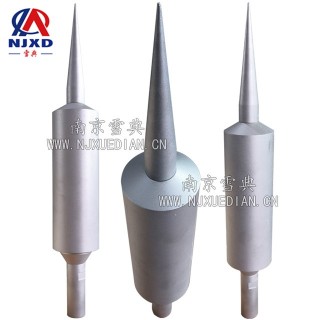NEWS
Application and installation of lifting lightning arrester equipment
Time:2020-09-03 View:

Application of Xuedian NJXD lifting lightning arrester equipment
Illustration on the application of lift-type lightning arrester equipment is summarized by the skilled personnel of Nanjing Xuedian Lighting Co., Ltd. The lift-type lightning arrester is planned to be a lift-up structure, which can deal with the question that the aerial light blocking lamp can not be maintained and replaced in the high air, and can ensure the safety and reliability of lightning transmission on the lift-up contact surface together. Aviation, the air lamp is connected with the Lightning arrester to prevent lightning discharge from damaging the air obstruction lamp.
Because all power, electrical appliances and lifting equipment are located in the Lightning arrester inside of the casing can be to make the lifting equipment from damage, Lightning arrester Rod, Lightning arrester lifter, Lightning arrester lifts, Lightning arrester lifting channels, the Lightning arrester lifting bracket can operate stably for a long time, and has the characteristics of convenient equipment, simple maintenance and replacement, and beautiful appearance.
In the thunderstorm climate, when there are charged clouds over the building, the lifting lightning arrester and the top of the building are induced by a lot of charges, because the lifting lightning arrester needle is pointed, so when electrostatic induction, the top conductor always gathers the most charge. In this way, the lift Lightning arrester gathers most of the charges.
Lightning arrester also forms a capacitor with these charged clouds, because it is relatively sharp, that is, the North and South Pole plates of this capacitor have a very small area, and the capacitor is also very small, that is to say, it can contain very few charges.
And it gathers most of the charges, so when there are more charges on the cloud, the air between the lifting lightning arrester and the cloud is easily broken down and become a conductor. In this way, the charged cloud layer and the Lightning arrester form a path and the Lightning arrester is grounded, so the lifting lightning arrester can import the charges on the cloud layer to the Earth, making it not pose risks to the construction of high-rise buildings and ensuring its safety.
Conventional lightning protection can be divided into direct lightning protection, induction lightning protection and comprehensive lightning protection. Lightning protection equipment for preventing direct lightning usually consists of three parts, namely lightning arrester, lead-down line and grounding body; Lightning arrester is divided into lightning arrester, Lightning arrester, Lightning arrester belt and lightning arrester net. The lightning protection principle of the lifting lightning arrester as the Lightning arrester is: The Lightning arrester is connected to the ground through the wire, forming equal potential difference with the ground, using its own height, the electric field of Lightning Cloud, which increases the electric field strength to the limit value, is distorted and begins to ionize and goes down to discharge;
The lift-type lightning arrester bursts top-level discharge under the effect of strong electric field, which constitutes the upward pilot discharge; The two will form a lightning path, and then flow into the earth to reach the lightning protection effect. In practice, Lightning arrester is a lightning rod, which can lead the surrounding lightning and discharge early, and transmit the lightning current to the ground through its own grounding conductor to prevent the maintenance policy from being directly struck by lightning.

Lift-type lightning arrester is widely used in the emergency lightning protection of troops, public security, fire fighting, construction, outdoor construction, large-scale cultural and sports activities, disaster relief and other emergency, as well as the lightning protection maintenance of some specific policies of troops.
The product features of mobile lift Lightning arrester. The mobile lift Lightning arrester has the function of direct lightning protection by connecting lightning and introducing lightning current to the Earth. High-strength aluminum-magnesium alloy profiles are selected for strong corrosion resistance; The inner wall of the cylinder is sealed and combined with high-pressure wear-resistant porcelain treatment technology. It has strong anti-rolling function.
It has the function of self-equipment and convenient mobile transportation. You can view and maintain the needle tip equipment to make it work normally. Strong ability to resist wind and can resist wind power of 60 m/s. Lightning protection maintenance radius is calculated according to the rolling ball method. It has the structural characteristics of high anti-corrosion, waterproof and dustproof, and has long service life. The lifting method can be manual or electric, and can also be manual and electric integration. Electromechanical integration controls the lifting, limiting, locking and sealing of lightning arrester. It can be controlled by electric cabinet or handle button. Be able to allocate early discharge lightning arrester or optimize lightning arrester (for example, allocate early discharge lightning arrester, the lightning protection maintenance radius shall be calculated according to relevant national rules).
How to install automatic lifting lightning arrester
Installation Requirements:
① the installation of the bottom plate of the lifting rod and the hoop must ensure that the rod body is perpendicular to the horizontal plane of the car body.
② the installation of the bottom plate and the hoop must ensure the accurate position at the same time, and one end cannot be fixed and the other end cannot be fixed forcibly due to improper position.
③ the hoop and bottom support should be installed on objects that cannot be displaced.
④ The clamp of the hoop to the rod body should not be too tight, so as not to make the deformation of the rod body affect the normal operation of the lifting rod.
The overall installation should also be determined according to the site conditions and party requirements.

CATEGORY
NEWS
- Automatic lifting lightning arrester lightning arrester lifter
- Application and installation of lifting lightning arrester equipment
- Price and device construction of mobile lifting lightning arrester
- Application and technical index of lifting rod of lightning arrester equipment
- Application and modification of mobile lighting lifting monitoring mast